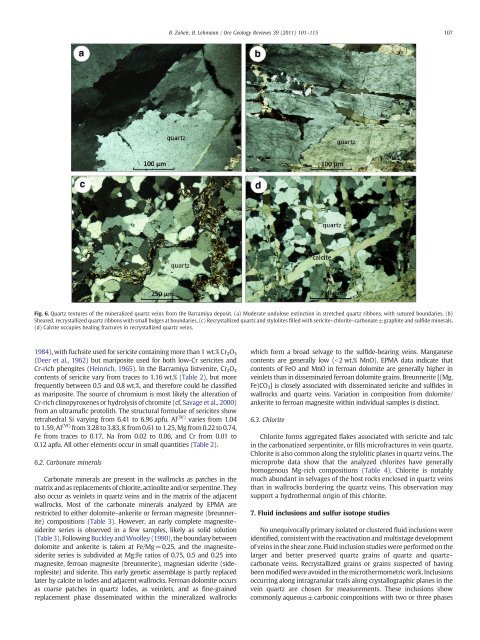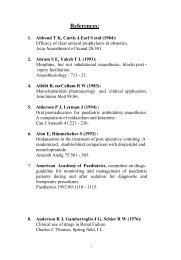Basem Ahmed Zoheir_Barramiya, OGR_2011.pdf
Basem Ahmed Zoheir_Barramiya, OGR_2011.pdf
Basem Ahmed Zoheir_Barramiya, OGR_2011.pdf
Create successful ePaper yourself
Turn your PDF publications into a flip-book with our unique Google optimized e-Paper software.
1984), with fuchsite used for sericite containing more than 1 wt.% Cr 2O 3<br />
(Deer et al., 1962) but mariposite used for both low-Cr sericites and<br />
Cr-rich phengites (Heinrich, 1965). In the <strong>Barramiya</strong> listvenite, Cr 2O 3<br />
contents of sericite vary from traces to 1.16 wt.% (Table 2), but more<br />
frequently between 0.5 and 0.8 wt.%, and therefore could be classified<br />
as mariposite. The source of chromium is most likely the alteration of<br />
Cr-rich clinopyroxenes or hydrolysis of chromite (cf. Savage et al., 2000)<br />
from an ultramafic protolith. The structural formulae of sericites show<br />
tetrahedral Si varying from 6.41 to 6.96 apfu. Al (IV) varies from 1.04<br />
to 1.59, Al (VI) from 3.28 to 3.83, K from 0.61 to 1.25, Mg from 0.22 to 0.74,<br />
Fe from traces to 0.17, Na from 0.02 to 0.06, and Cr from 0.01 to<br />
0.12 apfu. All other elements occur in small quantities (Table 2).<br />
6.2. Carbonate minerals<br />
Carbonate minerals are present in the wallrocks as patches in the<br />
matrix and as replacements of chlorite, actinolite and/or serpentine. They<br />
also occur as veinlets in quartz veins and in the matrix of the adjacent<br />
wallrocks. Most of the carbonate minerals analyzed by EPMA are<br />
restricted to either dolomite–ankerite or ferroan magnesite (breunnerite)<br />
compositions (Table 3). However, an early complete magnesite–<br />
siderite series is observed in a few samples, likely as solid solution<br />
(Table 3). Following Buckley and Woolley (1990), the boundary between<br />
dolomite and ankerite is taken at Fe/Mg=0.25, and the magnesite–<br />
siderite series is subdivided at Mg:Fe ratios of 0.75, 0.5 and 0.25 into<br />
magnesite, ferroan magnesite (breunnerite), magnesian siderite (sideroplesite)<br />
and siderite. This early genetic assemblage is partly replaced<br />
later by calcite in lodes and adjacent wallrocks. Ferroan dolomite occurs<br />
as coarse patches in quartz lodes, as veinlets, and as fine-grained<br />
replacement phase disseminated within the mineralized wallrocks<br />
B. <strong>Zoheir</strong>, B. Lehmann / Ore Geology Reviews 39 (2011) 101–115<br />
Fig. 6. Quartz textures of the mineralized quartz veins from the <strong>Barramiya</strong> deposit. (a) Moderate undulose extinction in stretched quartz ribbons, with sutured boundaries, (b)<br />
Sheared, recrystallized quartz ribbons with small bulges at boundaries, (c) Recrystallized quartz and stylolites filled with sericite–chlorite–carbonate ±graphite and sulfide minerals,<br />
(d) Calcite occupies healing fractures in recrystallized quartz veins.<br />
which form a broad selvage to the sulfide-bearing veins. Manganese<br />
contents are generally low (b2 wt.% MnO). EPMA data indicate that<br />
contents of FeO and MnO in ferroan dolomite are generally higher in<br />
veinlets than in disseminated ferroan dolomite grains. Breunnerite [(Mg,<br />
Fe)CO 3] is closely associated with disseminated sericite and sulfides in<br />
wallrocks and quartz veins. Variation in composition from dolomite/<br />
ankerite to ferroan magnesite within individual samples is distinct.<br />
6.3. Chlorite<br />
Chlorite forms aggregated flakes associated with sericite and talc<br />
in the carbonatized serpentinite, or fills microfractures in vein quartz.<br />
Chlorite is also common along the stylolitic planes in quartz veins. The<br />
microprobe data show that the analyzed chlorites have generally<br />
homogenous Mg-rich compositions (Table 4). Chlorite is notably<br />
much abundant in selvages of the host rocks enclosed in quartz veins<br />
than in wallrocks bordering the quartz veins. This observation may<br />
support a hydrothermal origin of this chlorite.<br />
7. Fluid inclusions and sulfur isotope studies<br />
No unequivocally primary isolated or clustered fluid inclusions were<br />
identified, consistent with the reactivation and multistage development<br />
of veins in the shear zone. Fluid inclusion studies were performed on the<br />
larger and better preserved quartz grains of quartz and quartz–<br />
carbonate veins. Recrystallized grains or grains suspected of having<br />
been modified were avoided in the microthermometric work. Inclusions<br />
occurring along intragranular trails along crystallographic planes in the<br />
vein quartz are chosen for measurements. These inclusions show<br />
commonly aqueous±carbonic compositions with two or three phases<br />
107

















